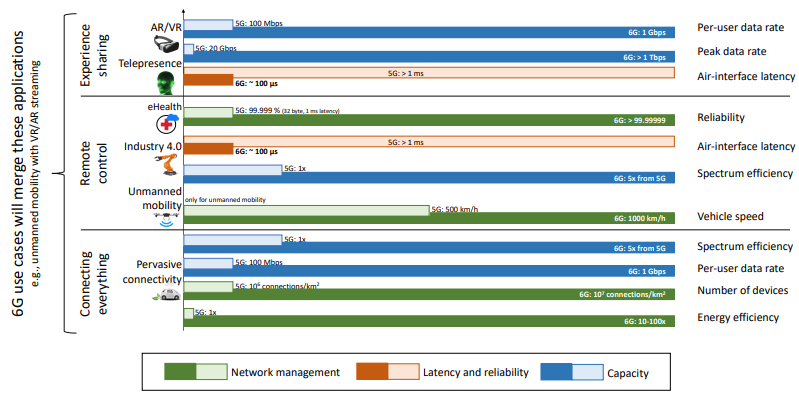Research Interests
My main research interests are in wireless communications , signal processing, and machine learning. The current focus is:
Research Projects
If you are interested on the following projects, just drop me an email. I am happy to work with you together.
Multimodal Semantic Communications
Semantic communications has been identified as the one of the potential technologies for the sixth-generation (6G) wireless network. Based on Shannon and Weaver, communication could be categorized into three levels: i) transmission of symbols; ii) semantic exchange of transmitted symbols; iii) effects of semantic information exchange. In the past decades, communications primarily focus on how to accurately and effectively transmit symbols (measured by bits) from the transmitter to the receiver, referring to first level. In such systems, bit-error rate (BER) or symbol-error rate (SER) is usually taken as the performance metrics. With the development from the first generation (1G) to the fifth generation (5G), the achieved transmission rate has been improved tens of thousands of times and the system capacity is gradually approaching to the Shannon limit. Various new applications appear, such as autonomous transportation, consumer robotics, environmental monitoring, and tele-health . The interconnection of these applications will generate a staggering amount of data in the order of zetta-bytes and require lower latency, which poses critical challenges to traditional source-channel coding. Semantic communications can process data in the semantic domain by extracting the meanings of data and filtering out the useless, irrelevant, and unessential information, which further compresses data while reserving the meanings. Moreover, semantic communication is expected to be robust to terrible channel environments. These factors motivate us to develop intelligent communication systems by considering the semantic meaning behind digital bits to enhance the accuracy and efficiency of communications.

♦ Related Works
[R1] H. Xie, Z. Qin and G. Y. Li, "Semantic Communication With Memory," in IEEE Journal on Selected Areas in Communications, vol. 41, no. 8, pp. 2658-2669, Aug. 2023. [IEEE]
[R2] H. Xie, Z. Qin, X. Tao and K.B. Letaief, "Task-Oriented Multi-User Semantic Communications," in IEEE Journal on Selected Areas in Communications, vol. 40, no. 9, pp. 2584-2597, Sept. 2022. [IEEE]
[R3] H. Xie, Z. Qin, G. Y. Li and B. -H. Juang, "Deep Learning Enabled Semantic Communication Systems," in IEEE Transactions on Signal Processing, vol. 69, pp. 2663-2675, Apr. 2021. [IEEE]
From Massive MIMO to Near-Field Communication
The success of the fifth-generation (5G) wireless network is based on the employment of large-scale antenna arrays. From the 5G evolved to 6G, the KPI requirements (e.g., throughput, latency etc) are expected to be much higher than 5G, which supports the future killing applications, such as extended reality (XR), holographic communication, pervasive intelligence, digital twin, and Metaverse. To reach the KPI requirements, excepted for the communication paradigm changes (e.g., semantic communications), the 6G is expected to employ the extremely large-scale antenna arrays, tremendously high frequencies, and new types of antennas. This cause a paradigm shift for the electromagnetic characteristics in 6G, in which the obvious change is the wave models around base station. Before 5G, the wave model is assumed as the planar wave, because the range of near-field region is limited to a few meters or even centimeters around the base stations. However, the range of near-field region will be enlarged to hundreds of meters in 6G due to the significant increase in the size of antenna arrays, extremely high frequencies, and the emerging new metamaterial-based antennas. The wave model will be transformed from planar wave to more complex wave models, such as spherical waves. Therefore, the assumption of planar wave will not be suitable for 6G, which requires new models and new designs for more complex wave models. These factors motivate us to investigate the near-field communications.

♦ Related Works
[R1] H. Xie, W. Xu, H. Q. Ngo and B. Li, "Non-Coherent Massive MIMO Systems: A Constellation Design Approach," in IEEE Transactions on Wireless Communications, vol. 19, no. 6, pp. 3812-3825, June 2020. [IEEE]
[R2] H. Xie; W. Xu; W. Xiang; K. Shao; S. Xu, "Non-Coherent Massive SIMO Systems in ISI Channels: Constellation Design and Performance Analysis," in IEEE Systems Journal, vol. 13, no. 3, pp. 2252-2263, Sept. 2019. [IEEE]
Large Model Empowered Wireless Communications
Large models has shown a human-like ability in intelligent tasks, which has been proposed as a promising new technology for achieving general artificial intelligence. The remarkable milestone is the launch of ChatGPT which shows the surprising ability to understand contextual conditions, generate multimodal data, analyze data, etc. In sharp contrast to the existing small models, the large models can solve zeroshot or few-shot tasks through in-context learning, generate controllably multimodal data through prompt engineering, split a complex problem into multiple simple problems through the chain of thought, and simulate the specified scenarios through role play. Besides, the artificial intelligence generated content (AIGC) also benefits from the large models, leading to more realistic and high-quality content generation, which has been widely applied in the many industries (e.g., news, media, finance, etc). These applications of large models can also significantly enhance the performance of wireless communications in terms of model training, data generation, and task execution. This opens up numerous research opportunities and directions.

♦ Related Works
[R1] H. Xie, Z. Qin, X. Tao, and Z. Han, "Towards Intelligent Communications: Large Model Empowered Semantic Communications," in IEEE Communication Magazine, July 2024. [IEEE]